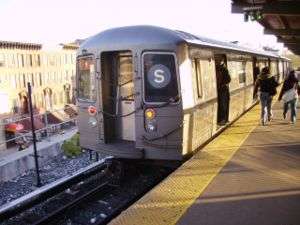R28 (New York City Subway car)
| R28 | |
|---|---|
| In service | 1960–2002 |
| Manufacturer | American Car and Foundry |
| Constructed | 1960-1961 |
| Scrapped | 2001–2002 |
| Number built | 100 |
| Number preserved | 4 |
| Number scrapped | 96 |
| Formation | Semi-Married Pairs |
| Fleet numbers | 7860-7959 |
| Capacity | 44 |
| Operator(s) | New York City Subway |
| Specifications | |
| Car body construction | LAHT carbon steel |
| Car length | 51.04 feet (15.56 m) |
| Width | 8.75 feet (2,667 mm) |
| Height | 11.86 feet (3,615 mm) |
| Doors | 6 per car |
| Maximum speed | 55 mph (89 km/h) |
| Weight | 70,000 lb (32,000 kg) (post-rebuild) |
| Traction system | General Electric 17KG192 (7860-7909 formerly Westinghouse) |
| Prime mover(s) | Westinghouse (WH) 1447J/JR, General Electric (GE) 1257F1 |
| Power output | 115 hp (85.8 kW) |
| Electric system(s) | 600 V DC Third rail |
| Current collection method | Contact shoe |
| Braking system(s) | WABCO, "SMEE" (electrodynamic) |
| Coupling system | H2C |
| Track gauge | 4 ft 8 1⁄2 in (1,435 mm) |
The R28 was a New York City Subway car built in 1960 and 1961 by American Car and Foundry (ACF).[1] They were a "follow-up" or supplemental stock for the "A" Division's R26s and closely resemble them. The average car cost per R28 was $114,495.[2] They operated on the IRT Division (also known as the A Division) in married pairs.
By 1982, all R28s had received air conditioning as part of a retrofitting program. The R28 cars were rebuilt between 1985 and 1987 and repainted into Redbirds by Morrison Knudsen in Hornell, New York, which extended their service lives. They were last in service operating on the 2 and 5 services before being retired in October 2002.
Retirements, scrapping and preservation
The R142 and R142A car orders replaced the entire R28 fleet.
Today, cars 7924-7925 and 7926-7927 survive. 7924-7925 are still on the New York City Subway property, and were used for work service until July 2013, when the pair was moved to Concourse Yard. 7926-7927 are currently in the Illinois Railway Museum collection undergoing restoration.
These were the last ever passenger cars built by ACF, with the final cars delivered in January 1961[3] with the closure of the Berwick assembly plant. ACF has since continued to focus on freight rolling stock.
Route assignment history
- 6 (1960–1966)-All cars
- 2/4/5 (1966–1976)-General Electric (GE) cars
- 2/5 (1976–1985)-General Electric (GE) cars
- 6 (1966–1985)-Westinghouse (WH) cars
- 7 (1978–1985)-some General Electric (GE) and Westinghouse (WH) cars as a temporary replacement for cars being sent out for air conditioning, overhaul and rebuilding
- 2/5 (1985–2002)-All cars after overhaul and rebuilding
Note; All cars became General Electric (GE) cars and became permanently paired with link bars after rebuilding.
See also
- R26 (New York City Subway car) - a very similar model also built by American Car & Foundry Company.
References
- ↑ George Chiasson, Jr. "A Historic Perspective of the R-26, R-28, and R-29". New York City Subway Resources. Retrieved December 24, 2010.
- ↑
- ↑ "IRT SMEE delivery dates", R36 Preservation, Inc. http://www.coronayard.com/r36preservation/irtsmeedelivery.html


